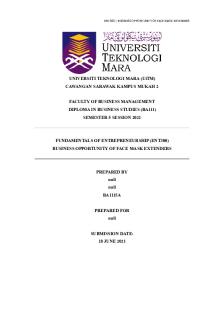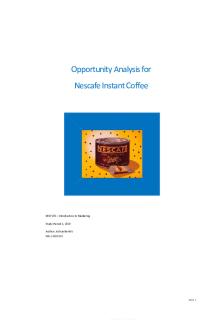Opportunity Evaluation - Summary PDF

| Title | Opportunity Evaluation - Summary |
|---|---|
| Course | New Venture Creation & Develop |
| Institution | University College Dublin |
| Pages | 6 |
| File Size | 486 KB |
| File Type | |
| Total Downloads | 97 |
| Total Views | 147 |
Summary
Full lecture notes & summaries on the topic of Opportunity Evaluation...
Description
Week 3 - Opportunity Evaluation and Feasibility Learning Objectives -
Describe the components of an opportunity analysis and discuss the primary issues to consider when completing this analysis
-
Explain what a feasibility analysis is and why it’s important
-
Describe an opportunity analysis tool and explain why it is important for entrepreneurs to use this template
Opportunity Evaluation Overview -
The Opportunity Evaluation Framework is a framework to aid the assessment of emergent entrepreneurial opportunities in the marketplace
-
It is important to understand the questions that need to be answered to fully understand the potential of an entrepreneurial opportunity (Roberts & Barley, 2004)
-
Before leaping from an idea to business plan, it is a good idea to do a thorough opportunity analysis. This is a piece of analysis that does not have a starting point that the business will be started. It begins with whether or not the idea is a viable one. (Roberts & Barley, 2004)
Mullins Framework (2018) - Opportunity Evaluation Framework
-
The Opportunity Evaluation Framework is a framework to aid the assessment of emergent entrepreneurial opportunities in the marketplace
-
The four domains that emerged from their research address the central elements in the assessment of any entrepreneurial opportunity
PART 1 - Is the opportunity valuable? (Market Analysis, Target Market Segment Benefits, Industry Analysis, Sustainable Advantage) Q1: Is the market attractive? (Market Analysis - Macro) -
A market consists of a group of current and/or potential customers having the willingness and ability to buy products – goods or services – to satisfy a particular class of wants or needs o This is an assessment of the overall appeal of the market for the product or service being produced
-
Does it take advantage of an environmental trend / Solves a problem/ Addresses an unfilled gap/ need in the marketplace o Size of Market – TAM (total addressable market) o Growth Rate o Segmentation o Adoption Curve
Q2: Does the idea offer target market segment benefits? (Micro) -
A target market is a place within a larger market segment that represents a narrower group of customers with similar needs. The challenge in identifying an attractive target market is to find a market that’s large enough for the proposed business but is yet small enough to avoid attracting larger competitors at least until the entrepreneurial venture can get off to a successful start o What are unmet needs in the marketplace and how are you going to fill them?
What customer pain will you resolve?
What benefits does your solution have that other solutions don’t?
What evidence do you have to show that your potential customers will buy, or that your target segment will grow?
Q3: Is the industry attractive? (Industry Analysis - Macro) -
It is important to note that markets and industries are not the same things. A market is a set of buyers (individuals, firms) and their needs. Industry analysis is a tool that facilitates a company's understanding of its position relative to other companies that produce similar products or services. Understanding the forces at work in the overall industry is an important component of entrepreneurial analysis. An industry consists of sellers – typically organizations – that offer a product or a class of products that are similar and close substitutes o When finished with this section you should understand the dynamics, problems, and opportunities driving your industry
3.1 Disruption Conditions - Creative Destruction / Competence Destroying Change 3.2 Industry Lifecycle Conditions
3.3 Industry Structure Conditions
-
3.1 Knowledge & Disruption o Some industries operate through:
Dynamics of creative destruction: entrepreneurs enter with new firms, challenge established firms on the basis of new ideas, disrupt the old ways of production, organization, and distribution, and replace the old firms
Dynamics of creative accumulation: entrepreneurs enter, challenge established firms on the basis of their new ideas. However, established firms defend their old ways of production, organization and distribution, and the new firms tend to fail
3.1 Competence Destroying Change
-
Large Companies
Small Companies
-
Locked into old ways of thinking
-
Can think in new ways
-
Must cannibalize existing
-
No concerns with existing
business
-
business
Hindered by established
-
Can form new routines
routines
-
easily
Must seek to satisfy existing
-
No existing customer base to
-
customers
satisfy
-
3.2 Industry Lifecycle
-
3.3 Industry Structure - Porters 5 Forces Framework
Q4: Does the idea offer sustainable advantage over other solutions to the customer’s needs? (Micro) -
One goal of every entrepreneur should be to get a competitive advantage in the marketplace. When you stand out from the competition by offering something of value that your competitors don't, you give your customers a better reason to choose your services. Without this advantage, you will get beat out by the competition time and time again
Part 2 - Is the opportunity feasible to pursue? Feasibility analysis is the process of determining if a business idea is viable to pursue -
Product Feasibility - Is an assessment of the overall feasibility of the designing and developing the product to successfully exploit the opportunity
-
Market Feasibility - Is an assessment of the overall feasibility of entering successfully a chosen target market
-
Organizational Feasibility - Is conducted to determine whether a proposed business has sufficient management expertise, organizational competence to successfully launch its business
-
Financial Sufficiency - Is conducted to determine whether the potential new venture has sufficient financial resources to move forward to successfully develop a product or service idea
Why assessment is important? -
Most business plans should have been abandoned before they were written
-
Business ideas must be able to pass them through a test to determine if they truly are valid opportunities o “Why will or won’t this work?
-
The crucial things to look for on the downside are elements of the market, industry or team that simply cannot be fixed by shaping the opportunity in a different way
-
If flaws that cannot be fixed are found, then the best thing to do is to abandon the opportunity at this early stage and move on to something more attractive
Slide Deck – Airbnb -
The company founders, Brian Chesky, Joe Gebbia and Nathan Blecharczyk used this pitch to raise $600K from Sequoia Capital and Y Ventures
-
The deck used by the founders was successful at summarizing the company vision and the huge market opportunity they had before them o 1- Problem, 2- Solution, 3- Opportunity & target market, 4- Tech, 5- Competition, 6- Sales & Marketing, 7- Management team, 8- Financials, 9- Financing sought, 10- Summary
Feasibility Analysis (Barringer and Ireland) Role of feasibility analysis in executing business ideas....
Similar Free PDFs

Opportunity Evaluation - Summary
- 6 Pages

Business Opportunity
- 17 Pages

Business Opportunity
- 14 Pages

Evaluation
- 4 Pages

Product Opportunity Gap
- 8 Pages

ENT300 Business Opportunity report
- 13 Pages

Opportunity Analysis final final
- 12 Pages

Unequal Opportunity Race
- 3 Pages

Marketing Opportunity Bsbmkg 501
- 7 Pages

ENT300 - Business Opportunity
- 13 Pages

Nike Blue Ocean Opportunity
- 4 Pages

Strategy and opportunity assessment
- 15 Pages

Business Opportunity Template
- 8 Pages
Popular Institutions
- Tinajero National High School - Annex
- Politeknik Caltex Riau
- Yokohama City University
- SGT University
- University of Al-Qadisiyah
- Divine Word College of Vigan
- Techniek College Rotterdam
- Universidade de Santiago
- Universiti Teknologi MARA Cawangan Johor Kampus Pasir Gudang
- Poltekkes Kemenkes Yogyakarta
- Baguio City National High School
- Colegio san marcos
- preparatoria uno
- Centro de Bachillerato Tecnológico Industrial y de Servicios No. 107
- Dalian Maritime University
- Quang Trung Secondary School
- Colegio Tecnológico en Informática
- Corporación Regional de Educación Superior
- Grupo CEDVA
- Dar Al Uloom University
- Centro de Estudios Preuniversitarios de la Universidad Nacional de Ingeniería
- 上智大学
- Aakash International School, Nuna Majara
- San Felipe Neri Catholic School
- Kang Chiao International School - New Taipei City
- Misamis Occidental National High School
- Institución Educativa Escuela Normal Juan Ladrilleros
- Kolehiyo ng Pantukan
- Batanes State College
- Instituto Continental
- Sekolah Menengah Kejuruan Kesehatan Kaltara (Tarakan)
- Colegio de La Inmaculada Concepcion - Cebu


